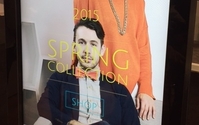 Beacons are about to cause yet another new twist on in-store
shopping.
Beacons are about to cause yet another new twist on in-store
shopping.
We know from various research studies that even though many people use their phones while they shop in stores, many also do not.
A novel in-store approach shown at the NRF
conference and expo this week highlighted how beacons can tap into mobile phones in a pocket or purse and leverage location information along with past behaviors to customize nearby on-screen
displays.
Those displays are on large store screens, not phone screens. The twist here is that the consumer never looks at their phone during the entire shopping process.
The idea is
to use beacon-triggered location information to provide highly targeted information that helps a shopper, without that consumer ever having to use their phone.
The beacon-enabled platform I
saw at the NRF Big Show this week was created by SapientNitro and is initially targeted to specialty retailers.
Many beacon implementations involve the sending of beacon-triggered messages,
such as ads, discounts or coupons, when a shopper nears a particular product or aisle.
The SapientNitro approach is the exact opposite, with no messaging ever being sent to a phone, even
though it has been beaconed.
“It recognizes the app coming into the store,” said Ryan Scott, vice president, strategy and platforms, at SapientNitro, who demonstrated the system
for me.
The large screen in the demonstration played a video highlighting a particular product or product category based on the profile of the person approaching the screen.
I’ve
seen other similar displays that use in-screen cameras to quickly identify the general demographics of a person looking at the screen and the adjust the images accordingly. In that case, personal
information about the viewer is typically unknown and the screen activity is not customized until viewing starts.
In the SapientNitro display, a Gimbal beacon at a store entrance triggers the
store’s app to identify the loyalty profile of the shoppers in advance of approaching a screen, since the app is linked into a store’s customer management system and loyalty program.
Such permissions would be included when the app is initially downloaded by the consumer, with the option to opt in or out.
The screen Scott demonstrated was also interactive, so that the
shopper, presumably now seeing a relevant item, could tap the screen to see different colors and sizes in real time.
Scott said that as a cart is built, it sends a message to a nearby sales
associate’s mobile device so that the salesperson sees what the consumer is shopping for and can offer assistance, if needed, since they also know the location of the customer.
The
overall concept of the beaconed screen activity is to enhance the in-store experience and provide more relevant videos or product displays for each shopper.
Scott suggested that a person
looking at their phone while shopping in a store can interrupt the shopping moment and once a person starts phone searching they can quickly be distracted from their initial item of interest.
Beacons are taking proximity marketing to a whole new level.
Welcome to the start of in-pocket beaconing.
______________________________________
Check out the coming
MediaPost IoT: Beacons conference agenda for Chicago Feb. 10.